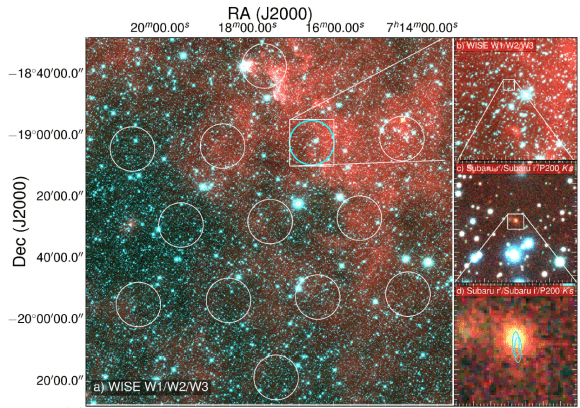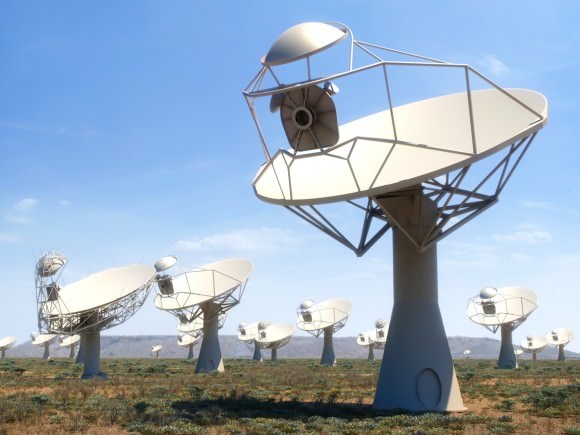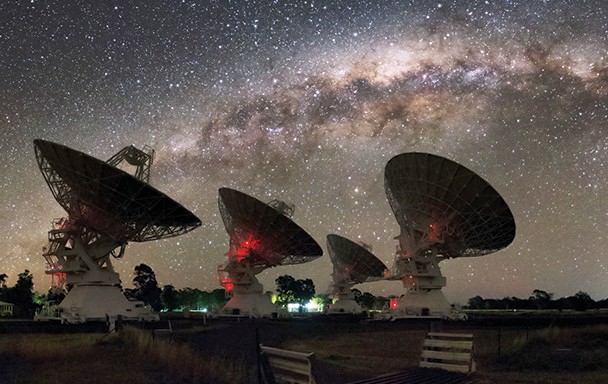In July of 2012, researchers at the CERN laboratory made history when they announced the discovery of the Higgs Boson. Though its existence had been hypothesized for over half a century, confirming its existence was a major boon for scientists. In discovering this one particle, the researchers were also able to confirm the Standard Model of particle physics. Much the same is true of our current cosmological model.
For decades, scientists been going by the theory that the Universe consists of about 70% dark energy, 25% dark matter and 5% “luminous matter” – i.e. the matter we can see. But even when all the visible matter is added up, there is a discrepancy where much of it is still considered “missing”. But thanks to the efforts of a team from the Commonwealth Scientific and Industrial Research Organization (CSIRO), scientists now know that we have it right.
This began on April 18th, 2015, when the CSIRO’s Parkes Observatory in Australia detected a fast radio burst (FRB) coming from space. An international alert was immediately issued, and within a few hours, telescopes all around the world were looking for the signal. The CSIRO team began tracking it as well with the Australian Telescope Compact Array (ATCA) located at the Paul Wild Observatory (north of Parkes).

With the help of the National Astronomical Observatory of Japan’s (NAOJ) Subaru telescope in Hawaii, they were able to pinpoint where the signal was coming from. As the CSIRO team described in a paper submitted to Nature, they identified the source, which was an elliptical galaxy located 6 billion light years from Earth.
This was an historic accomplishment, since pinpointing the source of FRBs have never before been possible. Not only do the signals last mere milliseconds, but they are also subject to dispersion – i.e. a delay caused by how much material they pass through. And while FRBs have been detected in the past, the teams tracking them have only been able to obtain measurements of the dispersion, but never the signal’s redshift.
Redshift occurs as a result of an object moving away at relativistic speeds (a portion of the speed of light). For decades, scientists have been using it to determine how fast other galaxies are moving away from our own, and hence the rate of expansion of the Universe. Relying on optical data obtained by the Subaru telescope, the CSIRO team was able to obtain both the dispersion and the redshift data from this signal.
As stated in their paper, this information yielded a “direct measurement of the cosmic density of ionized baryons in the intergalactic medium”. Or, as Dr. Simon Johnston – of the CSIRO’s Astronomy and Space Science division and the co-author of the study – explains, the team was not only to locate the source of the signal, but also obtain measurements which confirmed the distribution of matter in the Universe.
“Until now, the dispersion measure is all we had,” he said. “By also having a distance we can now measure how dense the material is between the point of origin and Earth, and compare that with the current model of the distribution of matter in the Universe. Essentially this lets us weigh the Universe, or at least the normal matter it contains.”
Dr. Evan Keane of the SKA Organization, and lead author on the paper, was similarly enthused about the team’s discovery. “[W]e have found the missing matter,” he said. “It’s the first time a fast radio burst has been used to conduct a cosmological measurement.”
As already noted, FRB signals are quite rare, and only 16 have been detected in the past. Most of these were found by sifting through data months or years after the signal was detected, by which time it would be impossible for any follow-up observations. To address this, Dr. Keane and his team developed a system to detect FRBs and immediately alert other telescopes, so that the source could be pinpointed.

It is known as the Square Kilometer Array (SKA), an international effort led by the SKA Organization to build the world’s largest radio telescope. Combining extreme sensitivity, resolution and a wide field of view, the SKA is expected to trace many FRBs to their host galaxies. In so doing, it is hoped the array will provide more measurements confirming the distribution of matter in the Universe, as well as more information on dark energy.
In the end, these and other discoveries by the SKA could have far-reaching consequences. Knowing the distribution of matter in the universe, and improving our understanding of dark matter (and perhaps even dark energy) could go a long way towards developing a Theory Of Everything (TOE). And knowing how all the fundamental forces of our universe interact will go a long way to finally knowing with certainty how it came to be.
These are exciting time indeed. With every step, we are peeling back the layers of our universe!
Further Reading: CSIRO, SKA Organization, Nature.


I have to admit that the term “ionized baryons” has me perplexed. I’ve only heard ionization used in reference to atoms or molecules (which obviously contain baryons in their nuclei) but never the more generic “baryon”. Would someone explain this?
That is correct. The signal measures the dispersion of the radio pulse, a frequency-dependent time delay. The slope of that relation is related to the density of electrons but the more massive nuclei have a negligible effect. That means they can measure how many free electrons there are but only infer the number of baryons. The number of protons from ionized hydrogen would equal the number of electrons released, for ionized helium there would be two electrons per nucleus but each nucleus contains four baryons. Traces of other elements would give different ratios but those are very sparse.
The choice of title for the article may be a bit misleading too, this has nothing to do with dark matter, it is a confirmation of the anticipated density of normal matter between galaxies where it is otherwise almost impossible to observe directly.
How desperate!! The current cosmological model is in such bad shape it appears scientists will grasp at anything and label it as verification of the current model.
There is absolutely no proof that dark matter, dark energy, or even “black holes” exist. This latest finding also offers no proof whatsoever.
The whole sad mess is caused by the incorrect concept that gravity is the driving force for galaxy and star formation as well as the structures at the centers of galaxies inappropriately termed “black holes”. Gravity has either little or no role in these processes.
The newest radio telescope data is refuting the standard model on almost a daily basis. For example, “black holes are now seen to have enormous magnetic fields, spew plasma jets and emit visible light. It is clear that they are electromagnetic phenomenon and are neither black nor holes. These galactic centers are most likely to be be massive, rapidly rotating plasmoids. It is not a coincidence that when we look at a star’s surface (i.e. the sun) we see only plasma and massive magnetic fields. Currents of charged particles flowing into and out of the sun have been thoroughly documented, most recently by the IBEX mission as published in the Astrophysical Journal October 2015 Supplement. These currents were found to be both interstellar and intergalactic. We can actually see these currents arriving at the earth as the Aurora Borealis. They are termed Birkeland currents.
Once cosmologists recognize that the only driving force powerful enough to cause planet, star and galaxy formation is electromagnetism they can steer away from the current embarrassing “standard model” and all of it’s imaginary mathematical concepts.
How Desperate! Scientists actually take actual measurements of actual conditions in order to prove me and my handful of whack-job nut case internet buddies wrong!! And there’s only multitudes of them, and all with credentials and degrees… LMFAO!
Am I reading it wrong? Surely the measurement is telling us that they have now found the missing matter that was previously only explained by theoretical undetectable particles, in which case [non-baryonic] “Dark Matter” skeptics should be pleased
The title is misleading, the article is about thin normal matter between galaxies, it is nothing to do with dark matter at all.
Yeesh, not this rubbish again. What happened to the mods removing crackpot spam like this?
Now all they have to do is find the source of an FRB is the opposite direction to confirm the results. Matter may not be distributed homogeneously through out the Universe.